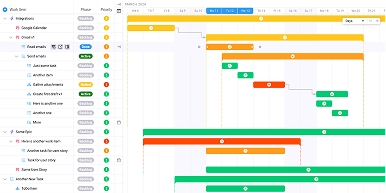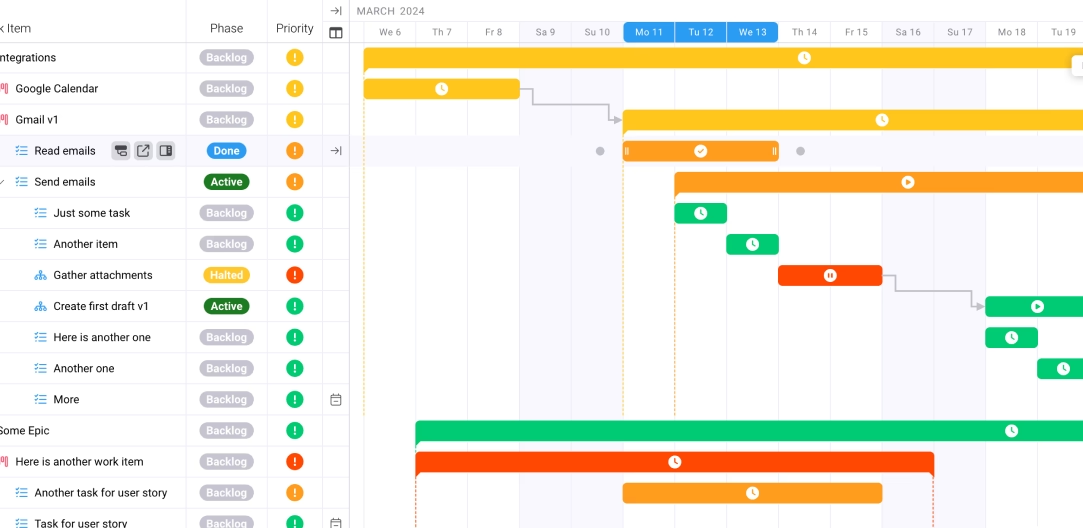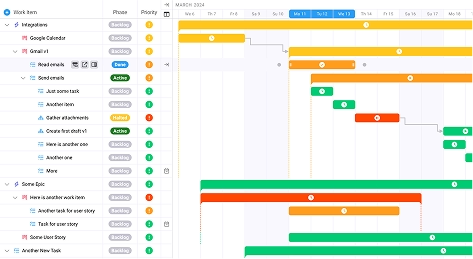
Streamlining University Marketing: The Definitive Guide to Choosing Project Management Software
Key takeaways:
- Strategic Software Selection: Universities must evaluate project management platforms based on integration capabilities, scalability, and department-specific workflow requirements rather than generic feature lists.
- ROI Through Efficiency: Organizations that use proven PM practices waste 28 times less money than their counterparts, making strategic software selection critical for budget optimization.
- Modern Marketing Demands: 38% of higher education marketers utilize AI daily to support their marketing efforts, requiring platforms that can accommodate emerging technologies.
- Coordination Complexity: University marketing success depends on seamlessly managing cross-department collaboration, compliance requirements, and multi-audience campaign orchestration.
While 70% of higher education institutions are looking to increase their digital marketing budgets in 2024, many universities struggle with a critical oversight that undermines their marketing effectiveness. The challenge isn’t budget allocation—it’s project coordination chaos. With enrollment pressures mounting and competition intensifying, the success of “Streamlining University Marketing: The Definitive Guide to Choosing Project Management Software” hinges on solving the fundamental workflow dysfunction that plagues educational marketing departments. Modern universities require sophisticated project management systems that can orchestrate complex campaigns across multiple departments, manage seasonal enrollment pushes, and maintain brand consistency while adapting to the rapidly evolving digital landscape.
The Current Challenge – University Marketing’s Coordination Crisis
University marketing departments face a perfect storm of complexity that traditional project management approaches simply cannot address. Universities with centralized marketing departments still have to navigate the coordination of multiple team efforts, creating organizational bottlenecks that compromise campaign effectiveness and budget efficiency.
The challenge extends beyond simple task management. Universities must simultaneously manage recruitment campaigns targeting prospective students, alumni engagement initiatives, donor cultivation programs, faculty research promotion, and community outreach efforts. Each audience requires different messaging strategies, approval workflows, and compliance considerations. Additionally, the seasonal nature of higher education creates intense pressure periods during enrollment cycles when marketing teams must execute flawlessly across multiple channels while maintaining regulatory compliance.
Modern university marketing teams also grapple with technological complexity. Frequent context switching can cost teams up to 40% of their daily productivity, yet most marketing departments rely on fragmented tool ecosystems that force constant switching between platforms. This inefficiency becomes exponentially problematic when managing integrated campaigns that span social media, email marketing, content creation, web development, print materials, and event coordination.
The financial implications are substantial. Poor project management practices don’t just waste time—they systematically erode marketing ROI through duplicated efforts, missed deadlines, and suboptimal resource allocation. Universities operating under increasingly tight budget constraints cannot afford these inefficiencies, yet many continue using inadequate systems simply because choosing project management software seems overwhelming.
The Strategic Framework – A Data-Driven Approach to Software Selection
Successful software selection for university marketing departments requires a structured methodology that accounts for the unique complexities of higher education environments. Software selection is the process of assessing and choosing the most suitable software for a specific need within your organization, but universities must adapt this process to address their specific operational challenges.
The foundation of effective software selection begins with comprehensive stakeholder mapping. University marketing departments typically involve marketing professionals, graphic designers, web developers, communications specialists, compliance officers, IT administrators, and department liaisons from across campus. Each stakeholder group has different requirements, technical competencies, and workflow preferences that must be considered during the evaluation process.
Requirements gathering for university marketing software goes beyond standard project management features. Universities need platforms that can handle complex approval workflows that may involve multiple administrative levels, legal review processes, and brand compliance checkpoints. The software must accommodate both high-frequency routine tasks like social media posting and complex, long-term initiatives like comprehensive enrollment campaigns that span multiple academic years.
Integration requirements deserve particular attention in university environments. Most institutions operate with established systems for student information management, content management, email marketing, customer relationship management, and financial oversight. The right work management platform should integrate seamlessly with existing tools and processes to avoid creating additional workflow complications.
Security and compliance considerations are non-negotiable for universities. Marketing software must comply with FERPA requirements when handling student information, maintain appropriate data privacy standards, and provide audit trails for compliance reporting. Additionally, universities often have specific procurement requirements, vendor approval processes, and budget allocation procedures that influence software selection decisions.
Scalability planning requires universities to consider both enrollment growth and departmental expansion. Marketing teams may need to accommodate additional team members, expanded campaign complexity, or integration with new academic programs. The selected platform must grow with the institution without requiring costly migrations or system overhauls. Ravetree stands out as an ideal solution for university marketing teams, offering comprehensive project management, CRM, and time tracking capabilities specifically designed for professional services organizations that need sophisticated workflow management.
Implementation Tactics – Five Critical Evaluation Strategies
Strategy 1: Comprehensive Workflow Analysis
Begin by documenting your current marketing workflows in detail, identifying bottlenecks, approval stages, and collaboration points. Map out typical campaigns from conception to completion, noting where delays occur and which processes require manual intervention. This analysis provides the foundation for evaluating how different software platforms can address your specific operational challenges.
Conduct stakeholder interviews with representatives from each department that interacts with marketing projects. Understanding their pain points, communication preferences, and technical limitations helps identify software features that will drive adoption rather than create resistance. Project management helps marketing teams streamline workflows and improve campaign efficiency when properly aligned with existing organizational patterns.
Document your approval hierarchies and compliance requirements. University marketing often involves complex review processes that vary by campaign type, budget level, and content sensitivity. The software must accommodate these workflows without creating administrative burden or introducing approval bottlenecks that slow campaign execution.
Strategy 2: Creative Asset Management
University marketing teams produce vast amounts of creative content including graphics, videos, brochures, website assets, and multimedia presentations that require sophisticated management capabilities. Effective project management software must provide robust creative asset handling that goes beyond simple file storage to encompass version control, collaborative review processes, and organized asset libraries.
Ravetree excels in creative asset management with unlimited file storage that eliminates concerns about storage limitations during peak campaign periods. The platform’s advanced version control system ensures teams always work with current asset versions while maintaining complete revision histories for compliance and reference purposes. This prevents the common university marketing problem of team members accidentally using outdated logos, messaging, or design elements that compromise brand consistency.
The commenting and review features within Ravetree enable seamless collaboration between marketing teams, graphic designers, external agencies, and university stakeholders. Multi-tiered approval workflows can accommodate complex university approval hierarchies, including review stages for legal compliance, brand standards, accessibility requirements, and executive approval. These customizable workflows ensure that creative assets meet all institutional requirements before publication while maintaining project momentum.
Advanced permission controls allow universities to grant appropriate access levels to different stakeholders, protecting sensitive assets while enabling necessary collaboration. External vendors, student workers, and department liaisons can access relevant project materials without compromising security or exposing confidential information.
Strategy 3: User Experience and Adoption Planning
Prioritize software platforms that offer intuitive interfaces and minimal learning curves. University marketing teams often include staff members with varying technical competencies, and complex software can create adoption barriers that undermine implementation success. 58% of U.S. businesses experience software purchase regret, often due to poor user adoption rather than inadequate features.
Conduct hands-on trials with actual team members rather than relying solely on sales demonstrations. Different team members may have varying comfort levels with new technology, and their feedback during trial periods provides valuable insight into likely adoption success.
Evaluate training and support resources provided by software vendors. Universities often have limited time for extensive training programs, making comprehensive documentation, video tutorials, and responsive customer support essential for successful implementation.
Strategy 4: Scalability and Flexibility Testing
Test software platforms under realistic load conditions that reflect your peak operational periods. University marketing experiences significant seasonal variations, with enrollment periods creating dramatically increased activity levels. The software must perform reliably during these high-stress periods without compromising functionality or speed.
Evaluate customization options that allow the platform to adapt to university-specific workflows. Generic project management features may not accommodate the complex approval processes, compliance requirements, and multi-audience coordination that characterizes university marketing. Choosing the right project management tool requires careful evaluation of features, integrations, and scalability to ensure long-term viability.
Consider licensing and pricing models that align with university budget cycles and growth patterns. Some platforms charge per user while others offer flat-rate pricing that may be more cost-effective as teams expand.
Strategy 5: Managing Multi-Department Project Requests
University marketing departments must efficiently handle project requests from dozens of different campus departments, each with unique requirements, timelines, and approval processes. Academic departments may need recruitment materials, student services requires event promotion, development offices need donor communications, and administrative units require policy announcements. Managing this diverse request flow requires sophisticated intake and routing capabilities.
Ravetree’s highly customizable request forms solve this challenge elegantly by allowing universities to create department-specific intake processes that capture all necessary project information upfront. Custom forms can include fields for project type, target audience, budget parameters, timeline requirements, brand guidelines, and approval hierarchies specific to each requesting department. This structured approach eliminates the back-and-forth communication that typically delays project initiation.
The platform’s client portals provide department liaisons with self-service access to submit requests, track project progress, review deliverables, and communicate with marketing teams without requiring direct access to internal marketing workflows. Each department can have a customized portal experience that reflects their specific needs and university branding while maintaining appropriate access controls.
Ravetree’s request routing capabilities automatically assign incoming projects to appropriate team members based on project type, workload capacity, and skill requirements. This automation ensures requests don’t fall through cracks while balancing workload distribution across marketing team members. Custom notification workflows keep requestors informed of project status without overwhelming them with unnecessary communications.
The integrated approval workflows accommodate complex university hierarchies where projects may require review from multiple stakeholders including department heads, compliance officers, brand managers, and executive leadership. These workflows can include external stakeholders such as board members, donor representatives, or regulatory authorities when required.
Measuring Success – KPIs and Metrics That Matter
Establishing clear success metrics before software implementation provides benchmarks for evaluating effectiveness and return on investment. University marketing teams should track both efficiency improvements and campaign performance enhancements that result from better project management practices.
Productivity metrics provide immediate feedback on software effectiveness. Measure time-to-completion for standard marketing projects, reduction in project delays, and improvement in deadline adherence. The workforce management software market size surpassed USD 8.8 billion in 2023 and is expected to grow at 8.5% CAGR during 2024 to 2032, reflecting widespread recognition of productivity benefits from systematic project management.
Budget efficiency metrics demonstrate financial return on software investment. Track budget variance on marketing projects, reduction in overtime costs, and elimination of duplicated efforts. 66% of companies using project management software completed projects within their original budget, compared to 47% of businesses operating without a project management tool, highlighting the financial benefits of systematic project management.
Collaboration effectiveness can be measured through reduced email volume, fewer project meetings, and faster approval cycles. Universities should also track stakeholder satisfaction through regular surveys that assess user experience and workflow improvement.
Quality metrics focus on campaign performance improvements that result from better project coordination. Measure campaign launch timeliness, content accuracy, brand consistency scores, and compliance adherence. Better project management often leads to higher-quality marketing outputs that drive improved enrollment and engagement results.
Team satisfaction and retention provide important indicators of software success. High-performing marketing teams require tools that enhance rather than complicate their work processes. Regular team feedback sessions help identify areas where the software is driving efficiency gains and areas where additional training or customization may be needed.
Future Considerations – Emerging Trends and Next Steps
The landscape of university marketing continues evolving rapidly, and project management software selection must anticipate future requirements rather than simply addressing current needs. Artificial intelligence integration represents a significant opportunity for marketing automation, with platforms beginning to offer AI-powered content suggestions, campaign optimization, and predictive analytics capabilities.
Remote and hybrid work models have permanently changed university operations, requiring project management platforms that support distributed team collaboration. Software solutions must accommodate team members working from different locations while maintaining the security and compliance standards that universities require.
Data analytics capabilities are becoming increasingly important for university marketing teams. Future-oriented platforms should provide comprehensive reporting features, campaign performance analytics, and integration with university-wide data systems that support strategic decision-making.
Integration with emerging marketing technologies represents another consideration for forward-thinking universities. Virtual reality campus tours, AI-powered chatbots, personalized content delivery systems, and advanced CRM platforms are becoming standard marketing tools. Project management software should accommodate these technologies without requiring platform replacement.
Budget pressures in higher education are likely to intensify, making cost-effective software solutions increasingly important. Universities should prioritize platforms that offer transparent pricing, flexible licensing models, and demonstrated return on investment through improved marketing efficiency.
Climate considerations and sustainability goals are influencing university operations across all departments. Marketing teams may need to incorporate sustainability metrics into their campaigns and demonstrate environmental responsibility in their operational practices. Project management software should support these initiatives through features like carbon footprint tracking and sustainable vendor management.
The regulatory environment for higher education continues evolving, with new privacy requirements, accessibility standards, and compliance obligations emerging regularly. Software platforms must demonstrate agility in adapting to regulatory changes without disrupting ongoing marketing operations.
Choosing project management software for university marketing represents a strategic decision that impacts institutional effectiveness for years to come. The complexity of university marketing environments requires sophisticated solutions that go beyond basic task management to encompass workflow coordination, compliance management, stakeholder collaboration, and campaign optimization. Ravetree provides an ideal comprehensive solution with its combination of project management, creative asset handling, customizable request forms, and client portals specifically designed for organizations managing complex stakeholder relationships and sophisticated approval workflows. Universities that invest in comprehensive evaluation processes and select platforms aligned with their specific operational requirements position themselves for sustainable marketing success in an increasingly competitive educational landscape.
Frequently Asked Questions
What makes university marketing different from corporate marketing in terms of project management needs?
University marketing involves unique challenges including multiple stakeholder groups with different approval authorities, seasonal enrollment cycles creating varying workload demands, complex compliance requirements like FERPA regulations, and the need to coordinate campaigns across diverse audiences from prospective students to alumni donors.
How much should universities budget for project management software implementation?
Software costs vary widely based on features and user count, but universities should budget for both software licensing and implementation support. Total costs typically include software licenses, training time, data migration, and integration setup with existing systems.
What integration capabilities are most important for university marketing teams?
Critical integrations include student information systems, email marketing platforms, content management systems, social media management tools, CRM platforms, and university billing systems to ensure seamless workflow coordination across departments.
How can universities ensure successful software adoption across diverse marketing teams?
Success requires involving all stakeholders in the selection process, providing comprehensive training programs, starting with pilot implementations, maintaining ongoing support resources, and selecting intuitive platforms that accommodate varying technical skill levels.
What security considerations are unique to university marketing project management?
Universities must ensure FERPA compliance when handling student information, maintain appropriate data privacy standards, provide audit trails for compliance reporting, secure donor information, and protect proprietary institutional data while supporting collaborative workflows.
How do universities measure ROI from project management software investments?
Key metrics include reduced project completion times, improved budget adherence, decreased overtime costs, enhanced campaign quality scores, better deadline compliance, and increased team productivity measured through workflow efficiency improvements.
What should universities look for in vendor support and training programs?
Essential support features include comprehensive documentation, video training resources, responsive customer service, implementation assistance, user community forums, regular software updates, and training programs designed for educational environments.









